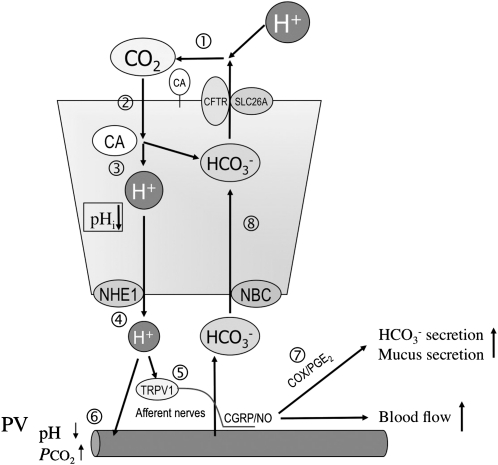FIGURE 1.
Model of acid/CO2-sensing mechanisms in the duodenum. The scheme summarizes how H+/CO2 traverses the mucosa and is sensed by the duodenum. (1) Luminal H+ from the stomach is neutralized with the secreted HCO3− in the duodenum, generating CO2, which is facilitated by extracellular carbonic anhydrase (CA). (2) CO2 diffuses into the cytoplasm through the apical membrane of the epithelial cells. (3) CO2 is converted into H+ and HCO3− by cytosolic CA. (4) H+ acidifies cells and is extruded into the subepithelium via Na+/H+ exchanger 1 (NHE1). (5) H+ stimulates acid sensors such as transient receptor potential vanilloid 1 (TRPV1), followed by the release of calcitonin gene–related peptide (CGRP) and nitric oxide (NO), which increases blood flow. (6) H+ is carried by blood flow, which acidifies portal vein (PV) blood. (7) Concurrently, cyclooxygenase (COX) produces prostaglandin E2 (PGE2), which signals HCO3− and mucus secretion, further protecting the mucosa. (8) Cytoplasmic HCO3− generated from CO2 and HCO3− delivered by increased blood flow, and then loaded via Na+:HCO3− cotransporter (NBC1), is secreted through an apical solute carrier family 26Ax (SLC26A) anion exchanger or cystic fibrosis transmembrane conductance regulator (CFTR) to the lumen. Note that the net movement of CO2 is lumen→mucosa (absorption), whereas net HCO3− movement is mucosa→lumen (secretion). These simultaneous movements result in net H+ absorption, which is consistent with the function of the Jacobs-Stewart cycle. pHi, intracellular pH.

